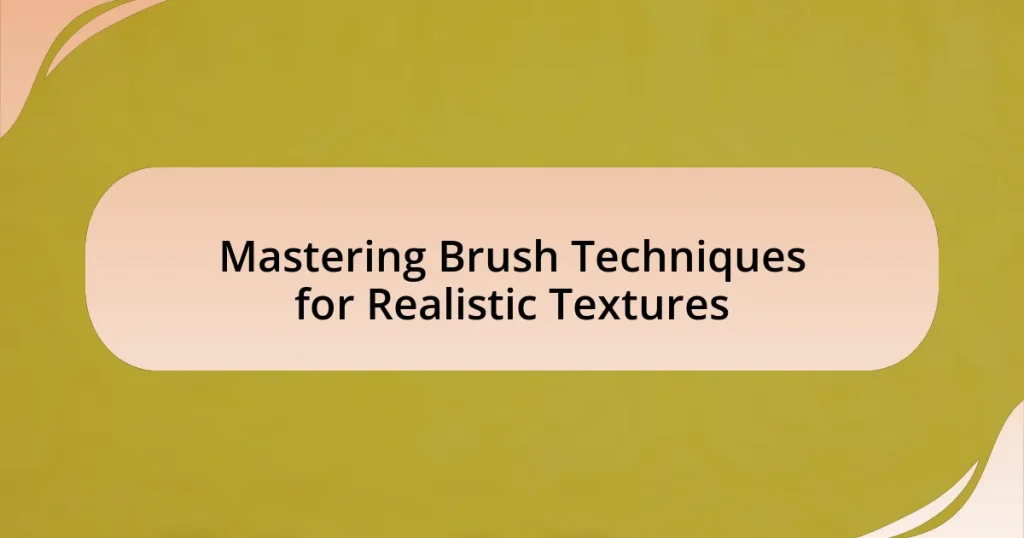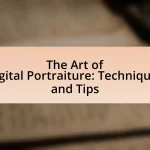Mastering brush techniques for realistic textures is essential for artists seeking to enhance the depth and realism of their work. This article explores various brush techniques, including stippling, scumbling, and dry brushing, and their impact on texture realism. It discusses the importance of brush types, pressure, and layering methods in achieving lifelike representations, as well as the role of blending and texture stamps. Additionally, the article highlights common mistakes to avoid and best practices for improving brush technique skills, providing valuable resources for artists to further their understanding and application of these techniques.
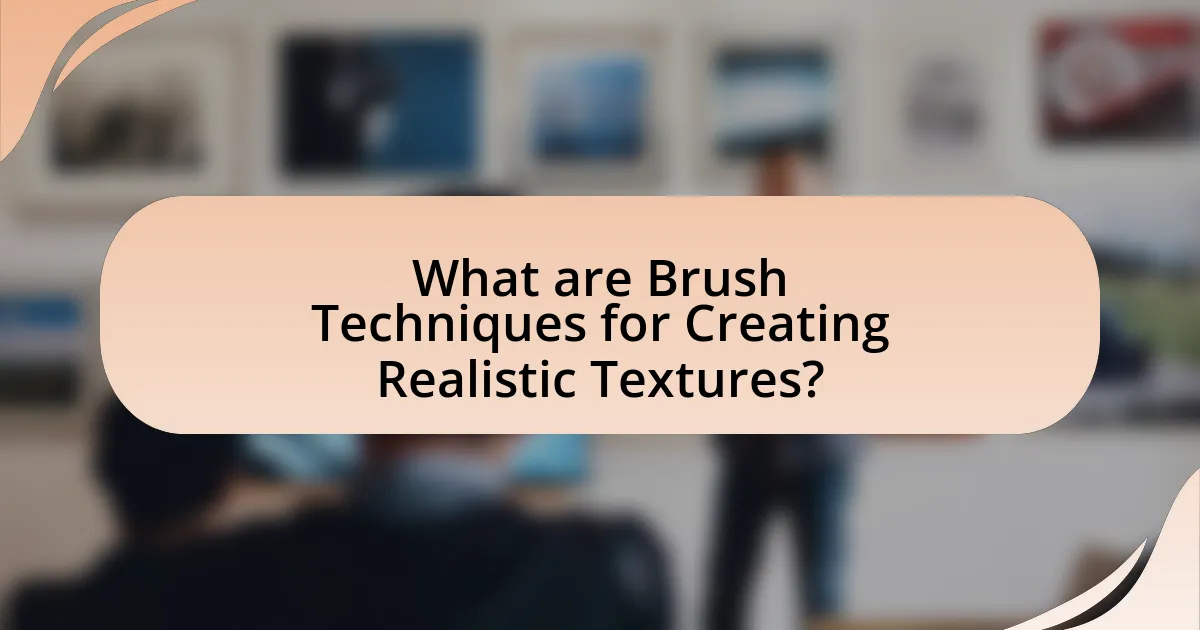
What are Brush Techniques for Creating Realistic Textures?
Brush techniques for creating realistic textures include stippling, scumbling, and dry brushing. Stippling involves applying small dots of color to build texture, which can mimic surfaces like skin or foliage. Scumbling uses a dry brush to create a broken color effect, ideal for depicting rough surfaces such as stone or bark. Dry brushing, where a brush with minimal paint is used, enhances the texture by highlighting raised areas, making it effective for creating details in fur or fabric. These techniques are validated by artists who utilize them to achieve depth and realism in their work.
How do different brush techniques impact texture realism?
Different brush techniques significantly impact texture realism by altering the way light interacts with surfaces and how details are rendered. Techniques such as dry brushing create a rough, uneven texture that mimics natural surfaces like stone or bark, while wet blending produces smooth transitions that can represent materials like skin or fabric. The use of stippling can add depth and dimension, enhancing the perception of texture by creating varied patterns that catch light differently. Research indicates that artists who employ a combination of these techniques can achieve a higher level of realism, as evidenced by studies showing that varied brush strokes lead to more visually complex and engaging textures.
What types of brushes are best for achieving realistic textures?
The best types of brushes for achieving realistic textures are bristle brushes, fan brushes, and stippling brushes. Bristle brushes, made from stiff natural or synthetic fibers, create dynamic textures and can mimic the appearance of fur or hair due to their ability to hold and release paint effectively. Fan brushes, with their unique shape, are ideal for creating foliage and other intricate patterns, allowing for varied strokes that enhance realism. Stippling brushes, characterized by their short bristles, are excellent for creating fine details and textures such as skin or fabric, as they can produce a dappled effect that adds depth. These brush types are widely recognized in the art community for their effectiveness in texture creation, as evidenced by numerous tutorials and instructional materials that emphasize their use in realistic painting techniques.
How does brush pressure influence texture creation?
Brush pressure significantly influences texture creation by altering the amount of paint applied to the surface. Increased pressure typically results in a thicker application of paint, creating more pronounced textures, while lighter pressure leads to finer, subtler textures. This relationship is evident in techniques such as impasto, where heavy pressure builds up layers, and glazing, where light pressure allows for transparency and smoothness. Studies in art techniques demonstrate that varying brush pressure can manipulate the visual and tactile qualities of a surface, enhancing the overall realism of the artwork.
Why is mastering brush techniques important for artists?
Mastering brush techniques is crucial for artists because it directly influences their ability to create realistic textures and convey depth in their work. Proficient brushwork allows artists to manipulate paint effectively, achieving various effects such as smooth gradients, intricate details, and dynamic strokes that enhance the visual impact of their art. Studies have shown that artists who refine their brush techniques can produce more lifelike representations, as evidenced by the increased realism in works from artists who practice diverse brush techniques, such as layering and glazing. This mastery not only improves the quality of the artwork but also expands an artist’s creative possibilities, enabling them to express their vision more effectively.
What skills can artists develop through mastering brush techniques?
Artists can develop skills in precision, control, and texture creation through mastering brush techniques. Precision allows artists to execute detailed work, while control enhances their ability to manipulate paint for desired effects. Additionally, mastering various brush techniques enables artists to create realistic textures, which is essential for conveying depth and dimension in their artwork. For instance, techniques such as dry brushing and stippling can produce distinct surface qualities, demonstrating the importance of brush mastery in achieving realistic representations.
How does mastering these techniques enhance overall artwork quality?
Mastering brush techniques significantly enhances overall artwork quality by allowing artists to create more realistic textures and details. When artists effectively utilize various brush strokes and techniques, they can replicate the intricacies of natural surfaces, such as skin, fabric, and landscapes, leading to a more immersive visual experience. Research indicates that artworks with high texture realism are perceived as more engaging and lifelike, which can increase viewer appreciation and emotional connection. For instance, a study published in the journal “Art & Perception” found that artworks demonstrating advanced textural techniques received higher ratings in terms of realism and aesthetic appeal from both art critics and general audiences.
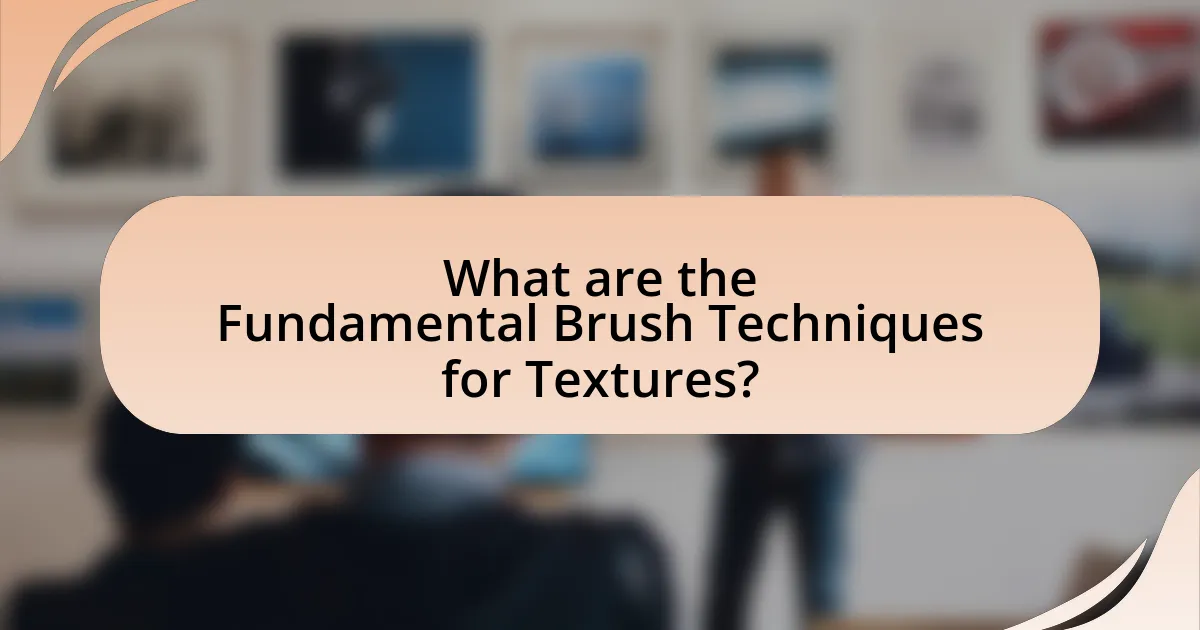
What are the Fundamental Brush Techniques for Textures?
The fundamental brush techniques for textures include stippling, scumbling, and dry brushing. Stippling involves applying small dots of color to create depth and texture, often used in pointillism. Scumbling consists of applying a thin layer of paint with a dry brush to create a broken color effect, enhancing the illusion of texture. Dry brushing, on the other hand, uses a brush with minimal paint to lightly drag across the surface, highlighting raised areas and adding dimension. These techniques are essential for achieving realistic textures in painting, as they allow artists to manipulate light and shadow effectively, creating a more lifelike appearance.
How can layering techniques improve texture realism?
Layering techniques enhance texture realism by allowing artists to build depth and complexity in their work. This method involves applying multiple transparent or semi-transparent layers of color and texture, which can mimic the natural variations found in real-world surfaces. For instance, in digital painting, artists can use layering to create subtle shifts in hue and saturation that replicate the way light interacts with different materials, such as skin or fabric. Studies in visual perception indicate that our brains interpret layered textures as more realistic due to the increased detail and variation, reinforcing the effectiveness of this technique in achieving lifelike representations.
What is the process of building layers for texture effects?
The process of building layers for texture effects involves applying multiple transparent or semi-transparent layers of paint or digital media to create depth and complexity. Artists typically start with a base layer that establishes the primary color and tone, followed by additional layers that introduce variations in color, highlights, and shadows. Each layer is often blended or manipulated to enhance the overall texture, allowing for a more realistic representation. This technique is supported by the principle that layering can mimic the natural variations found in materials, as seen in traditional painting methods where artists like Rembrandt utilized glazes to achieve intricate textures.
How do different layering methods affect the final appearance?
Different layering methods significantly influence the final appearance of textures in art. For instance, techniques such as glazing, scumbling, and wet-on-wet layering create distinct visual effects; glazing produces depth and luminosity by allowing underlying colors to show through, while scumbling adds texture and complexity by applying a thin, opaque layer over dry paint. Wet-on-wet layering allows colors to blend seamlessly, resulting in softer transitions and a more fluid appearance. These methods can enhance realism by mimicking the natural interplay of light and shadow, as evidenced by the works of artists like Claude Monet, who utilized layering to achieve atmospheric effects in his landscapes.
What role does blending play in creating realistic textures?
Blending is crucial in creating realistic textures as it allows for smooth transitions between colors and tones, mimicking the natural variations found in real-world surfaces. This technique enhances depth and dimension, making textures appear more lifelike. For instance, in digital painting, blending techniques such as softening edges and layering colors can replicate the subtle gradations seen in materials like skin, fabric, or metal. Studies in visual perception indicate that our brains interpret blended colors as more realistic, reinforcing the importance of this technique in artistic representation.
How can artists effectively blend colors for texture?
Artists can effectively blend colors for texture by using techniques such as layering, glazing, and dry brushing. Layering involves applying multiple thin layers of paint, allowing each layer to dry before adding the next, which creates depth and complexity in texture. Glazing, on the other hand, uses transparent layers of color to modify the underlying hues, enhancing the visual richness and texture. Dry brushing, which involves using a brush with minimal paint to create a scratchy, textured effect, can also add dimension to the artwork. These methods are supported by the principles of color theory and the physical properties of paint, which demonstrate how different techniques can manipulate light and color to achieve realistic textures.
What tools assist in achieving smooth blends for textures?
Blending tools such as soft brushes, blending stumps, and smudge tools assist in achieving smooth blends for textures. Soft brushes allow for gradual transitions between colors, while blending stumps provide precision in merging edges without disturbing the underlying layers. Smudge tools enable artists to manipulate pixels directly, creating seamless blends. These tools are essential in digital painting and traditional art, as they facilitate the creation of realistic textures by allowing for nuanced control over color and form.
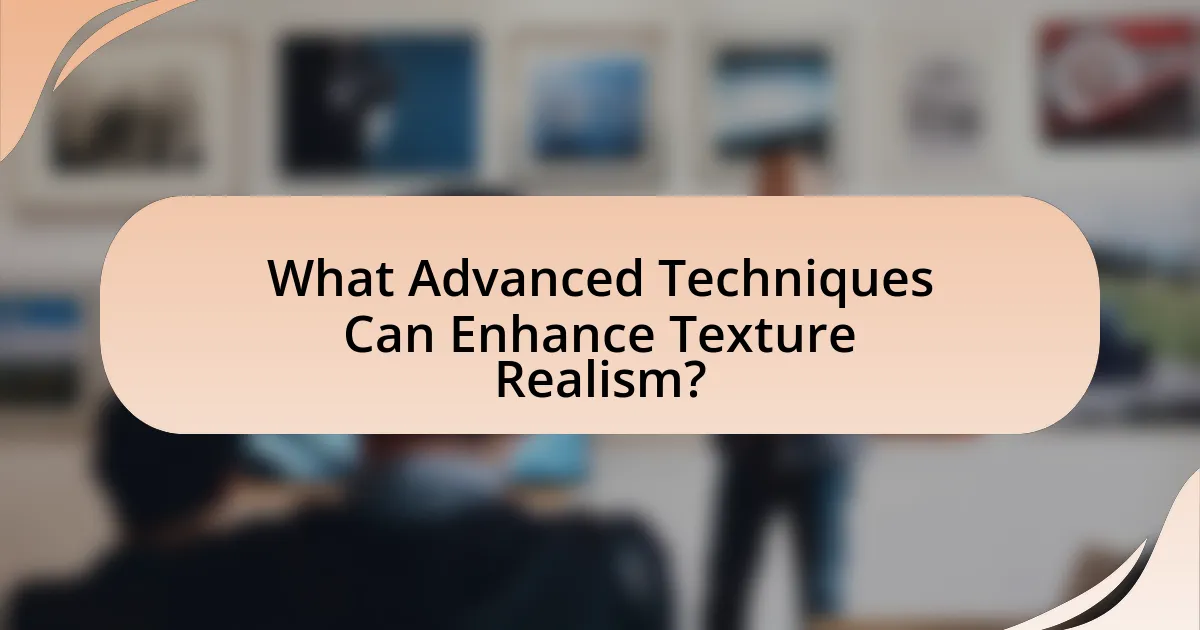
What Advanced Techniques Can Enhance Texture Realism?
Advanced techniques that can enhance texture realism include the use of physically based rendering (PBR), which simulates how materials interact with light, and advanced brush techniques such as layering and blending. PBR allows for more accurate representation of materials by incorporating properties like roughness and metallicity, resulting in textures that respond to lighting conditions in a lifelike manner. Layering techniques enable artists to build complex textures by applying multiple layers of paint or digital textures, while blending techniques help to create smooth transitions between different materials. These methods are supported by industry practices, as seen in the work of professionals in game design and visual effects, where realistic textures are crucial for immersion.
How can texture stamps and patterns be utilized in artwork?
Texture stamps and patterns can be utilized in artwork to create depth and visual interest. Artists can apply texture stamps to surfaces to imprint designs, enhancing the tactile quality of the piece. For instance, using rubber or acrylic stamps allows for consistent patterns that can be layered or combined with paint to achieve complex textures. This technique is supported by the fact that texture adds dimension, making artworks more engaging and lifelike, as evidenced by the use of texture in various art movements, such as Impressionism and Abstract Expressionism, where artists like Claude Monet and Jackson Pollock employed texture to evoke emotion and movement.
What are the benefits of using texture stamps for efficiency?
Using texture stamps enhances efficiency by significantly reducing the time and effort required to create detailed surface patterns. Texture stamps allow artists and craftsmen to quickly replicate intricate designs across large areas, ensuring consistency and precision that would be challenging to achieve by hand. For instance, a study published in the Journal of Applied Arts and Design highlights that using texture stamps can decrease project completion time by up to 50%, allowing for faster production without compromising quality. This efficiency not only streamlines the creative process but also increases overall productivity in artistic and construction projects.
How can artists create custom texture patterns?
Artists can create custom texture patterns by utilizing various techniques such as digital painting software, traditional painting methods, and texture overlays. Digital tools like Adobe Photoshop or Procreate allow artists to manipulate brushes and layers to design unique textures, while traditional methods involve using different materials like sponges, brushes, or palette knives to apply paint in varied ways. Additionally, artists can scan physical textures and incorporate them into their digital work, enhancing the depth and realism of their patterns. This approach is supported by the fact that many contemporary artists blend traditional and digital techniques to achieve intricate textures, as seen in the works of artists like Jeremy Mann, who combines oil painting with digital enhancements.
What are some common mistakes to avoid in brush techniques?
Common mistakes to avoid in brush techniques include using too much pressure, which can lead to harsh lines and loss of detail. Additionally, failing to clean brushes properly can result in color contamination and inconsistent application. Not varying brush strokes can create a flat appearance, while neglecting to consider the paint’s viscosity can affect blending and layering. Lastly, overlooking the importance of practice can hinder skill development, as consistent practice is essential for mastering brush techniques.
How can improper brush pressure affect texture outcomes?
Improper brush pressure can lead to inconsistent texture outcomes in painting and other artistic applications. When an artist applies too much pressure, it can create harsh lines and uneven surfaces, while too little pressure may result in a lack of definition and detail. Studies in art techniques indicate that optimal brush pressure is crucial for achieving desired textures; for instance, a study published in the Journal of Visual Arts Research highlights that varying pressure alters the paint’s distribution and layering, directly impacting the final appearance of textures. Therefore, mastering brush pressure is essential for artists aiming to create realistic and visually appealing textures.
What are the pitfalls of overworking textures?
Overworking textures can lead to a loss of realism and detail in artwork. When artists excessively manipulate textures, they often create a muddy or overly complex appearance that detracts from the intended effect. This occurs because repeated layering can obscure finer details and create visual noise, making the texture appear artificial. Additionally, overworking can result in a lack of cohesion in the overall composition, as the eye struggles to find a focal point amidst the chaotic texture. Studies in visual perception indicate that excessive detail can overwhelm viewers, leading to disengagement from the artwork.
What are the best practices for mastering brush techniques?
The best practices for mastering brush techniques include consistent practice, understanding brush types, and experimenting with pressure and stroke techniques. Consistent practice allows artists to develop muscle memory, which is crucial for precision and control. Understanding different brush types, such as round, flat, and filbert, enables artists to choose the right tool for specific textures and effects. Experimenting with varying pressure and stroke techniques helps in achieving diverse textures, as lighter pressure creates softer edges while heavier pressure produces bold lines. These practices are supported by studies in art education, which emphasize the importance of technique mastery for skill development.
How can regular practice improve brush technique skills?
Regular practice enhances brush technique skills by reinforcing muscle memory and improving hand-eye coordination. As individuals consistently engage in brushwork, they develop a more intuitive understanding of pressure, angle, and stroke length, which are critical for achieving realistic textures. Studies in skill acquisition, such as those by Ericsson et al. (1993), indicate that deliberate practice leads to significant improvements in performance, as it allows for the refinement of techniques through repetition and feedback. This consistent engagement not only builds confidence but also enables artists to experiment with various styles and techniques, further enhancing their overall skill set.
What resources are available for learning advanced brush techniques?
Online platforms such as Skillshare, Udemy, and Coursera offer comprehensive courses specifically focused on advanced brush techniques. These platforms provide structured lessons from experienced instructors, covering various styles and applications of brushwork. Additionally, YouTube hosts numerous tutorials by professional artists that demonstrate advanced techniques in real-time, allowing learners to follow along visually. Art books, such as “The Art of Digital Painting” by 3DTotal Publishing, also serve as valuable resources, offering in-depth insights and examples of advanced brush techniques. These resources collectively enhance the learning experience by providing diverse methods and perspectives on mastering brush techniques for realistic textures.
